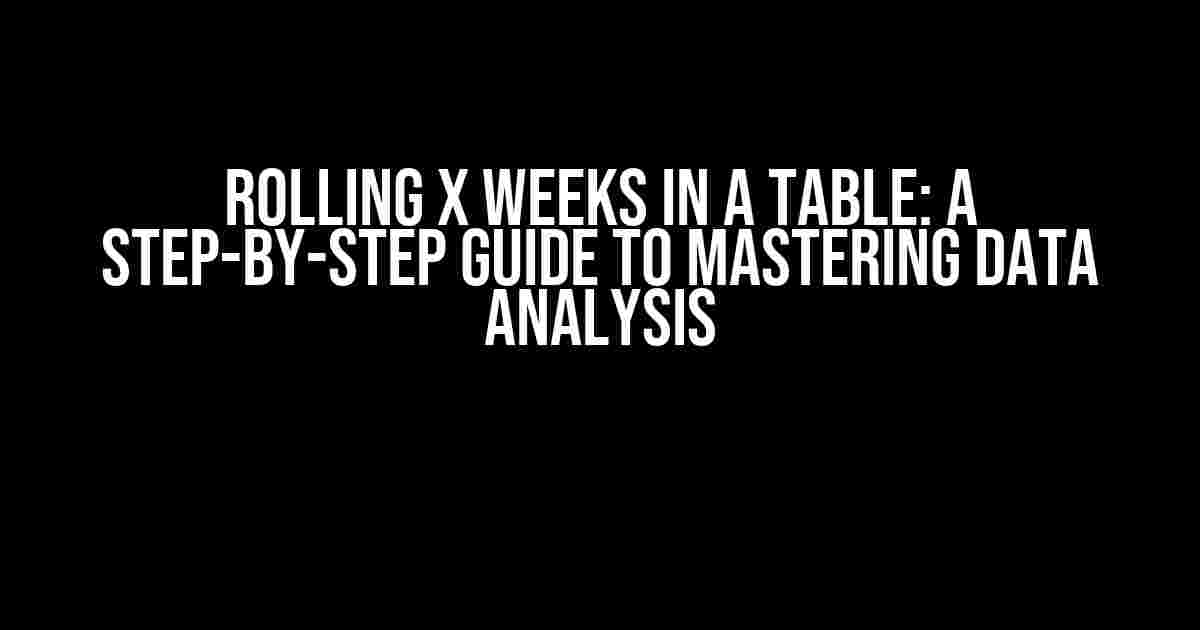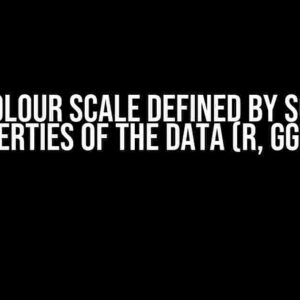Welcome to the world of data analysis, where numbers tell a story and tables are the canvas. In this article, we’ll dive into the fascinating realm of rolling X weeks in a table, a technique that will revolutionize the way you approach data visualization and insights. Buckle up, and let’s get started!
What is Rolling X Weeks in a Table?
A rolling X weeks in a table is a data analysis technique that involves calculating aggregations over a moving window of data. Think of it like a camera lens focusing on a specific time frame, but instead of capturing images, we’re capturing data insights. This technique is particularly useful when working with time-series data, helping you identify trends, patterns, and correlations that might have gone unnoticed.
Why Do We Need Rolling X Weeks in a Table?
The answer is simple: to gain a deeper understanding of our data. Rolling X weeks in a table allows us to:
- Smooth out fluctuations and noise in the data
- Highlight seasonal trends and patterns
- Identify correlations between different data points
- Make more accurate predictions and forecasts
Preparation is Key: Setting Up Your Data
Before we dive into the rolling X weeks technique, make sure your data is in order. Follow these steps to prepare your data:
Collect and clean your data: Gather your data from various sources, and ensure it’s accurate, complete, and free from errors.Organize your data into a table: Structure your data into a table with clear headers and columns. This will make it easier to work with and analyze.Choose your time frame: Decide on the time frame you want to analyze. This could be daily, weekly, monthly, or quarterly data, depending on your goals and requirements.
The Rolling X Weeks Formula
Now that your data is prepared, it’s time to apply the rolling X weeks formula. The basic formula is:
=SUMIFS(range, criteria, [X] weeks)
Where:
rangeis the column or range of cells containing the data you want to analyzecriteriais the condition or criteria you want to apply to the data (e.g., date range, category, etc.)[X] weeksis the number of weeks you want to roll up or aggregate
Example: Rolling 4 Weeks in a Table
Let’s say you want to calculate the total sales for the last 4 weeks. Here’s an example table:
| Date | Sales |
|---|---|
| 2022-01-01 | 100 |
| 2022-01-08 | 120 |
| 2022-01-15 | 150 |
| 2022-01-22 | 180 |
To calculate the rolling 4 weeks sales, you would use the following formula:
=SUMIFS(B:B, A:A, ">="&TODAY()-28, "<="&TODAY())
Where:
B:Bis the column containing the sales dataA:Ais the column containing the datesTODAY()-28is the start date of the 4-week range (28 days ago)TODAY()is the end date of the 4-week range (today)
Common Scenarios and Variations
The rolling X weeks formula can be adapted to various scenarios and requirements. Here are a few examples:
Average Sales over 8 Weeks
To calculate the average sales over the last 8 weeks, you can modify the formula as follows:
=AVERAGEIFS(B:B, A:A, ">="&TODAY()-56, "<="&TODAY())
Where:
B:Bis the column containing the sales dataA:Ais the column containing the datesTODAY()-56is the start date of the 8-week range (56 days ago)TODAY()is the end date of the 8-week range (today)
Rolling 12 Weeks with Multiple Criteria
Imagine you want to calculate the total sales for the last 12 weeks, but only for a specific region and product category. You can add multiple criteria to the formula as follows:
=SUMIFS(B:B, A:A, ">="&TODAY()-84, "<="&TODAY(), C:C, "North", D:D, "Category A")
Where:
B:Bis the column containing the sales dataA:Ais the column containing the datesC:Cis the column containing the region data (North)D:Dis the column containing the product category data (Category A)TODAY()-84is the start date of the 12-week range (84 days ago)TODAY()is the end date of the 12-week range (today)
Best Practices and Common Mistakes
When working with rolling X weeks in a table, keep the following best practices and common mistakes in mind:
- Use consistent date formatting: Ensure your dates are in a consistent format to avoid errors and confusion.
- Avoid overlapping ranges: Make sure to adjust your rolling window to avoid overlapping ranges, which can lead to incorrect calculations.
- Test your formulas: Verify your formulas are working correctly by testing them with sample data.
- Watch out for missing data: Be aware of missing data points or gaps in your data, which can affect the accuracy of your calculations.
Conclusion
Mastering the art of rolling X weeks in a table is a valuable skill for any data analyst or enthusiast. By following the steps and examples outlined in this article, you'll be well on your way to unlocking valuable insights and trends in your data. Remember to stay flexible, adapt to changing requirements, and always keep your data preparation and analysis in top shape.
Happy rolling!
Frequently Asked Question
Get ready to roll with the answers to your most pressing questions about rolling x weeks in a table!
What does "rolling x weeks" even mean in a table?
When we say "rolling x weeks", we're talking about a moving window of data that captures the last x weeks' worth of information. It's like taking a snapshot of your data every week, and then using that snapshot to analyze the past x weeks. This helps you identify trends, patterns, and insights that might be hidden in the noise!
How do I set up a rolling x weeks table in my spreadsheet?
Easy peasy! To set up a rolling x weeks table, you'll need to use a combination of formulas and functions. First, create a column with dates, and then use a formula to calculate the rolling sum or average of your data over the desired number of weeks. You can use the `OFFSET` function to create a dynamic range that shifts with the dates. Boom!
What kind of data is best suited for a rolling x weeks table?
Rolling x weeks tables are perfect for analyzing time-series data that has a strong periodic component, like sales, website traffic, or stock prices. You can also use it to track things like customer behavior, marketing performance, or production metrics. Any data that has a natural flow or rhythm can benefit from a rolling x weeks analysis!
Can I use a rolling x weeks table to predict future trends?
Yes, you can! A rolling x weeks table provides a solid foundation for forecasting future trends. By analyzing the patterns and trends in your historical data, you can identify potential opportunities or challenges that might be coming down the pipeline. Just be sure to combine your rolling x weeks analysis with some good old-fashioned business acumen and domain expertise!
Are there any limitations to using a rolling x weeks table?
While rolling x weeks tables are super powerful, they're not a silver bullet. One major limitation is that they can be sensitive to outliers or anomalies in your data. Additionally, if your data is highly seasonal or has strong trends, you might need to use more advanced techniques to account for those factors. Just keep these limitations in mind, and you'll be rolling with the punches in no time!


